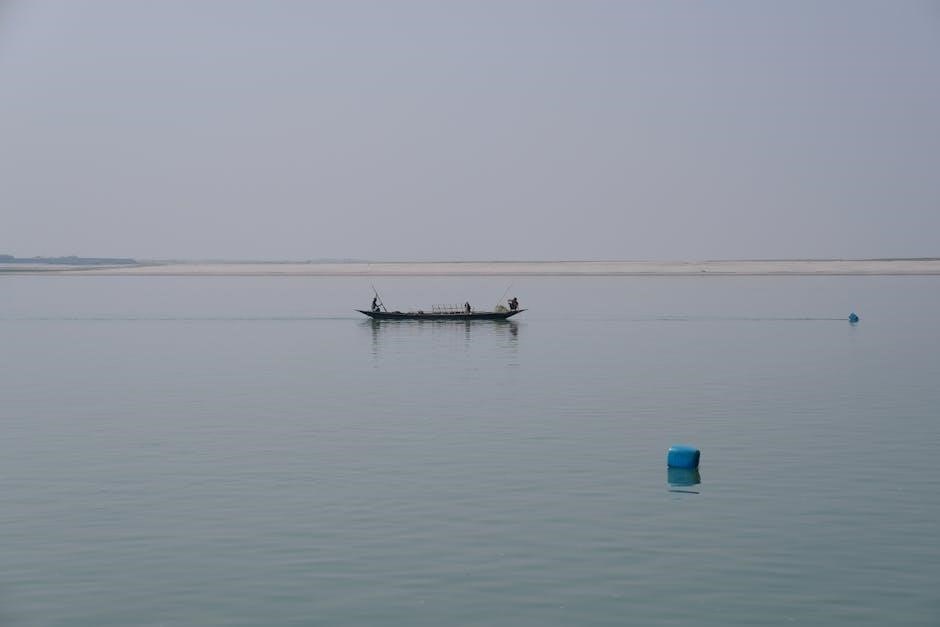Stephen Crane’s The Open Boat is a gripping short story based on his real-life shipwreck experience. First published in 1897, it vividly portrays four men’s struggle for survival at sea. The tale is celebrated for its realistic narrative and exploration of nature’s indifference. Available as a PDF, it remains a seminal work in American literature, offering readers a harrowing yet profound glimpse into human resilience against overwhelming odds.
Key Themes and Symbolism in the Story
Stephen Crane’s The Open Boat explores profound themes of nature’s indifference, human resilience, and existential struggle. The story symbolizes the fragile relationship between humanity and the natural world, with the vast, unrelenting sea representing the universe’s apathy toward human fate. The small boat, a fragile refuge, symbolizes human existence, emphasizing vulnerability in the face of overwhelming forces. The four men—each with distinct roles—represent the collective human condition, united in their struggle for survival.
- Nature’s Indifference: The sea’s relentless, unfeeling power contrasts with the men’s desperation, highlighting humanity’s insignificance in the grand scheme of existence.
- Survival and Perseverance: Despite the odds, the men’s determination to survive underscores the human spirit’s capacity to endure even in hopeless circumstances.
- Solidarity and Isolation: The men’s shared plight creates a bond, yet their individual thoughts reveal inner isolation, reflecting the duality of human connection and alienation.
The story’s vivid imagery and symbolic elements, such as the recurring bird and the waves’ relentless rhythm, reinforce its themes, creating a deeply philosophical and haunting narrative.

Historical Context and Stephen Crane’s Inspiration
Stephen Crane, an American author and journalist, drew inspiration for The Open Boat from his harrowing real-life experience during a shipwreck in 1896. While en route to Cuba to cover the Spanish-American War, Crane’s ship, the SS Commodore, sank off the coast of Florida. He survived by enduring 30 hours in a small dinghy with three other men, an ordeal that deeply influenced his writing. Born in 1871 in Newark, New Jersey, Crane was the youngest of 14 children to a Methodist minister. His early exposure to storytelling and his journalistic career shaped his unique narrative style, blending realism with poetic imagery.
The late 19th-century literary landscape, marked by the rise of naturalism, further influenced Crane’s work. Naturalism emphasized the harsh realities of life and humanity’s struggle against nature, themes central to The Open Boat. Crane’s vivid depiction of the sea’s indifference and the men’s futile efforts to control their fate reflects the era’s literary shift from Romanticism to a more gritty realism.
Crane’s personal ordeal and the cultural currents of his time converged to create a story that remains a landmark of American literature, offering profound insights into human resilience and the natural world’s unforgiving power.

Availability of “The Open Boat” in PDF Format
Stephen Crane’s The Open Boat is widely available in PDF format, making it easily accessible to readers worldwide. Since the story is in the public domain, it can be freely downloaded from various online platforms, including Google Books, Project Gutenberg, and ManyBooks. Additionally, educational websites and literary archives often provide downloadable PDF versions, ensuring its availability for students and enthusiasts alike.
The PDF format allows readers to access the story on multiple devices, such as smartphones, tablets, and e-readers, making it convenient for on-the-go reading. Many versions include annotations, study guides, and historical context, enhancing the reader’s understanding of Crane’s work. The story’s popularity in PDF format has also led to its inclusion in digital libraries and course materials, further cementing its place in literary education.
With its enduring relevance and ease of access, The Open Boat remains a seminal work in American literature, offering readers a poignant exploration of human resilience and nature’s indifference. Its availability in PDF ensures that Crane’s masterpiece continues to reach new generations of readers, providing a timeless and immersive reading experience.
Major Characters and Their Roles
The story revolves around four distinct characters, each representing different facets of human nature. The oiler, the strongest and most capable of the group, embodies resilience and physical endurance. His pragmatic approach contrasts with the philosophical musings of the correspondent, who serves as the narrative voice, reflecting on the existential implications of their ordeal.
The cook and the captain complete the quartet, each contributing unique dynamics. The cook, though often overlooked, provides subtle moments of humor and practicality, while the captain, despite his injuries, maintains a sense of authority and decision-making. Together, these characters illustrate the complexities of survival, highlighting themes of camaraderie, despair, and the human condition.
Through their interactions, Crane delves into the psychological and emotional struggles of men facing nature’s indifference. Each character’s role underscores the story’s exploration of fate, survival, and the search for meaning in the face of adversity. Their distinct personalities and reactions to the crisis create a rich tapestry of human experience, making them central to the narrative’s enduring impact.

Literary Style and Narrative Techniques
Stephen Crane’s The Open Boat is renowned for its distinctive literary style and masterful narrative techniques. Crane employs a naturalistic approach, immersing readers in the harsh, unrelenting environment of the sea. His vivid, descriptive language captures the brutality of nature, while his sparse, direct prose heightens the sense of realism and immediacy.
The story is told through an impersonal, detached narrator, creating an objective tone that emphasizes the characters’ vulnerability. Crane’s use of imagery, particularly the relentless, indifferent waves, serves as a powerful metaphor for the vast, uncaring natural world. The narrative structure, which blends present action with introspective musings, adds depth to the characters’ psychological states.
Crane also employs symbolism, with the small boat representing humanity’s fragility against nature’s might. The seagull, a recurring symbol, adds layers of meaning, possibly signifying hope or the indifferent gaze of fate. The dialogue is concise yet evocative, revealing character traits and heightening tension. Overall, Crane’s literary style and techniques create a gripping, thought-provoking tale that explores human resilience and the existential struggle against an indifferent universe.
The Story’s Relevance and Cultural Impact
Stephen Crane’s The Open Boat remains a timeless tale that resonates with readers due to its exploration of universal themes such as human resilience, nature’s indifference, and existential inquiry. The story’s relevance endures as it captures the essence of survival against overwhelming odds, a struggle that is universally relatable.
Culturally, The Open Boat has left an indelible mark on literature. It is often studied in educational settings for its philosophical depth and literary craftsmanship. The narrative’s vivid imagery and psychological insights have influenced numerous writers and artists, solidifying its place as a cornerstone of American literary naturalism.
The story’s accessibility in PDF format has ensured its continued popularity. Readers can easily download and engage with this classic, allowing its themes and messages to reach new generations. Its enduring appeal lies in its ability to provoke thought on the human condition, making it a significant work in cultural and literary discourse.

Reading Guide and Study Tips
Reading The Open Boat requires careful attention to its rich symbolism and philosophical undertones. Start by understanding the historical context of Stephen Crane’s own shipwreck experience, as it heavily influenced the story. Pay close attention to the interactions between the four characters, as they reveal themes of survival, fate, and human resilience.
When studying the story, focus on Crane’s use of imagery and descriptive language. Highlight passages that depict the sea’s power and the men’s emotional states. Analyze the symbolism of the boat, waves, and the distant lighthouse, as these elements carry deeper meanings about existence and nature’s indifference.
For a deeper understanding, explore the naturalist movement in literature, of which Crane was a key figure. Discuss the story’s themes in a group setting, such as the struggle between humanity and nature or the idea of cosmic indifference. Use the PDF version to easily reference specific scenes or quotes during your analysis. Finally, reflect on how the story’s message remains relevant today, offering insights into human perseverance and the unpredictability of life.

Critical Analysis and Reviews
Critical analysis of The Open Boat highlights its masterful portrayal of human struggle against nature. Critics praise Crane’s vivid imagery and philosophical depth, emphasizing themes of survival, fate, and existential inquiry. The story’s naturalist style, reflecting Crane’s own shipwreck experience, underscores the indifference of nature to human plight.
Reviewers often note the story’s universal appeal, as it transcends its historical context to explore timeless questions about resilience and mortality. The PDF version of The Open Boat allows readers to engage deeply with Crane’s prose, facilitating analysis of his narrative techniques and thematic richness. Scholars and readers alike commend the work for its emotional and intellectual impact, solidifying its place in literary canon.
The Open Boat by Stephen Crane is a profound and haunting tale that captures the essence of human resilience in the face of nature’s indifference. Based on Crane’s own harrowing experience of surviving a shipwreck, the story offers a raw and unflinching depiction of four men battling the relentless sea. Through its vivid imagery and philosophical undertones, the narrative explores themes of survival, fate, and the existential struggle of humanity against an unforgiving universe.
The availability of The Open Boat in PDF format has made it easily accessible to modern readers, ensuring its timeless message continues to resonate. Crane’s mastery of naturalist storytelling and his ability to weave emotional depth into the narrative have solidified the tale’s place in literary history. Ultimately, The Open Boat is not just a story of survival but a poignant reflection on the human condition, leaving readers with a lasting appreciation for the power of both nature and the human spirit.


0 Comments